Scientists recently finished analyzing a partial sloth skeleton found in the Cupisnique Desert  of Peru in 1975 (Pujos et al., 2007). They estimate its age at 15-25,000 years old. The humerus (upper arm bone) matches one recovered by Swedish explorer, Erland Nordenskiold, in 1905 from a cave in the Andes called Casa del Diablo. They named the new species Diablotherium nordenskioldi and placed it in the Megalonychidae family, making it a close relative of our own Megalonyx. Nordenskiold suspected he had something special, and now it’s confirmed– Diablotherium was fully arboreal (tree-dwelling) and apparently as well-adapted to life off the ground as modern tree sloths. The discovery, the first species of this type ever found, underscores the tremendous adaptability of the ground sloths, especially the Megalonychidae.
of Peru in 1975 (Pujos et al., 2007). They estimate its age at 15-25,000 years old. The humerus (upper arm bone) matches one recovered by Swedish explorer, Erland Nordenskiold, in 1905 from a cave in the Andes called Casa del Diablo. They named the new species Diablotherium nordenskioldi and placed it in the Megalonychidae family, making it a close relative of our own Megalonyx. Nordenskiold suspected he had something special, and now it’s confirmed– Diablotherium was fully arboreal (tree-dwelling) and apparently as well-adapted to life off the ground as modern tree sloths. The discovery, the first species of this type ever found, underscores the tremendous adaptability of the ground sloths, especially the Megalonychidae.
Author Archives: David
Did a disease kill the sloths?
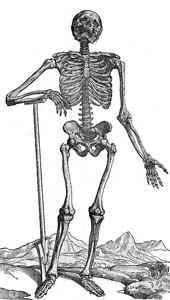 What kind of evidence of a disease would survive after 12,000 years? As a cause of death among animals, disease is probably a much more significant factor than predation, especially if they are under stress, though given the penchant of predators to pick out the weak and infirm, it may be difficult to distinguish (Shipman, 1981). A disease that could kill 3 sloths at once would have to have been dangerous and fast-acting, but can you prove it from fossils?
What kind of evidence of a disease would survive after 12,000 years? As a cause of death among animals, disease is probably a much more significant factor than predation, especially if they are under stress, though given the penchant of predators to pick out the weak and infirm, it may be difficult to distinguish (Shipman, 1981). A disease that could kill 3 sloths at once would have to have been dangerous and fast-acting, but can you prove it from fossils?
A hypervirulent disease has been suggested as a possible cause of the Pleistocene mass-extinction (MacPhee and Marx, 1997). The theory is humans or their dogs (or their fleas) brought a pathogen with them when they arrived in the New World, and while they were immune, the New World fauna was not, and large mammals died in unprecedented numbers–a dress rehearsal, if you will, for the devastation wreaked by measles, small pox, etc. when those pathogens arrived with Europeans 12,000 years later. But small pox didn’t exterminate dozens of species.
More rain
![]() It started raining last Friday and continued through Sunday. Officially 3.33 inches. Flash flood warnings for all of Page county. We don’t need a photo to know there’s at least 15 feet of water over the site. Dave
It started raining last Friday and continued through Sunday. Officially 3.33 inches. Flash flood warnings for all of Page county. We don’t need a photo to know there’s at least 15 feet of water over the site. Dave
How to Become a Fossil I: Get eaten by a pack of wolves
Why is it that only 6 Megalonyx skeletons of any consequence have ever been discovered and no direct adult-juvenile association at all, but we’re lousy with sloths? What’s so unique about the site or the circumstances surrounding our sloths’ deaths? Much progress has been made in understanding the processes of fossilization and decomposition, but the essential mystery remains–why do just a few thousandths of 1% of all bones become fossilized, absent embalming and burial? (Gill-King, 1997) How did we beat the odds?
External conditions (i.e. soil chemistry, microbes, etc.) are generally believed to determine the fate of bones, but Bell et al. (1996) suggest internal factors are more important. The bodies of all animals contain a host of microorganisms in their guts ready to escape after the death of their host and use its vascular and lymphatic systems to invade the major body organs. The microbes could be getting into the bone marrow by the Haversian canals that maintain the bones in life. The actions of predators, and their manner of killing–specifically, disemboweling prey and disrupting the microbial escape routes may be critical for explaining bone preservation. I love the irony–fall to predators but live forever as a fossil. Cool. Continue reading
New photos from the site
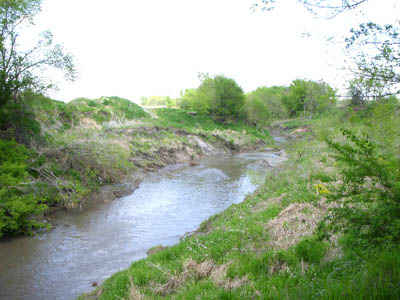
From the picnic area on top of the south bank.
These photos just arrived courtesy of sloth-digging veterans Pam and Marvin Belknap.
The water is high but not nearly as high as we expected after all the rain the area has received. Holmes thinks we may be able to go out and dig in July . He’ll talk to Bob this weekend and send an update to our sloth rapid response team next week.
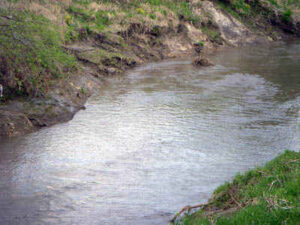
Looking upstream, North.
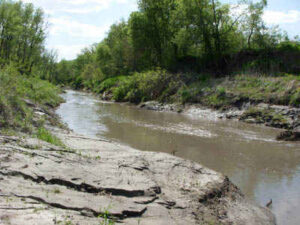
Looking downstream, South.
Did a drought kill the sloths?
 Can you explain the deaths of three sloths by anything other than some kind of catastrophe? In a drought herbivores congregate around the remaining water sources, and soon exhaust all the good forage near by. If the drought continues, eventually they die of malnutrition. Predators have plenty of meat available so they leave most of the carcasses undisturbed. Even scavengers that normally consume bones switch to soft tissue.
Can you explain the deaths of three sloths by anything other than some kind of catastrophe? In a drought herbivores congregate around the remaining water sources, and soon exhaust all the good forage near by. If the drought continues, eventually they die of malnutrition. Predators have plenty of meat available so they leave most of the carcasses undisturbed. Even scavengers that normally consume bones switch to soft tissue.
Did the sloths get mired in the mud and die?
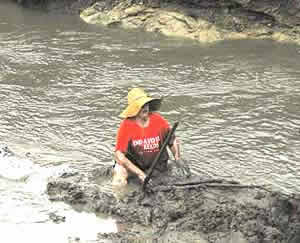 Heaven knows we’ve almost lost some students and one Bobcat operator to the muck at the site, but how reasonable is it to think a giant sloth could die that way? How about three sloths? Haynes (1988) has studied hundreds of elephant deaths and reports it’s actually not an uncommon event. Healthy adult elephants never have a problem even in the deepest thickest mud but very young animals and those who are ill or weak some times get stuck. He has also observed impala, Cape buffalo and black rhinos dying in this manner.
Heaven knows we’ve almost lost some students and one Bobcat operator to the muck at the site, but how reasonable is it to think a giant sloth could die that way? How about three sloths? Haynes (1988) has studied hundreds of elephant deaths and reports it’s actually not an uncommon event. Healthy adult elephants never have a problem even in the deepest thickest mud but very young animals and those who are ill or weak some times get stuck. He has also observed impala, Cape buffalo and black rhinos dying in this manner.
Did the sloths freeze?
If we knew the season in which the sloths died could that help tell us how they died? Does dying in the winter leave traces in fossils that dying in the summer doesn’t? The Iceman Murder case offers an intriguing idea for detecting freezing in fresh tissue. In 1983 Pennsylvania police found a corpse tightly wrapped in plastic bags dumped along a mountain road. Medical examiners performing the autopsy noticed an unusual pattern of decomposition and odor, and suggested to skeptical police that the victim had been kept frozen somewhere since he had disappeared over two years earlier. The examiners had spotted cavities in the victim’s tissues where the doctors hypothesized ice crystals had grow, distorting the surrounding tissue and leaving holes they called “ice crystal artifacts.” Their discovery eventually helped convict a New Jersey contract killer.
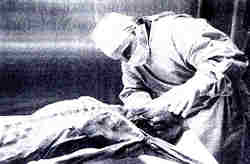 I’m wondering: 1) Do ice crystal artifacts form in bone? 2) If so, what do the holes look like and can they be distinguished from the post-mortem recrystallization of apatite that also enlarges the cavities? 3) Is the warping of the bone by the ice different in fresh bone versus weathered bone ? 4) Can we distinguish immediate post-mortem freezing from ice artifacts that form in subsequent winters? 5) Would ice crystal artifacts be more likely in one particular bone? 6) Will a thin-section of the bone show them? 7) What other clues does dying in winter leave?
I’m wondering: 1) Do ice crystal artifacts form in bone? 2) If so, what do the holes look like and can they be distinguished from the post-mortem recrystallization of apatite that also enlarges the cavities? 3) Is the warping of the bone by the ice different in fresh bone versus weathered bone ? 4) Can we distinguish immediate post-mortem freezing from ice artifacts that form in subsequent winters? 5) Would ice crystal artifacts be more likely in one particular bone? 6) Will a thin-section of the bone show them? 7) What other clues does dying in winter leave?
References
Zugibe, FT and Costello, JT. 1993. The Iceman Murder: One of a series of contract murders. Journal of Forensic Science 38: 1404-1408.
Did the sloths drown?
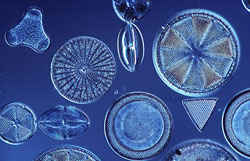
How do three sloths die all at the same time? One of my crazier ideas is maybe by falling through ice and drowning. I read a lot of forensic science literature hoping for an “Aah ha” moment when I find a technique that might give us a clue. We obviously can’t look for fluid in the sloths’ lungs, but forensic scientists have come up with an intriguing alternative–diatoms.
Drowning victims often inhale diatoms as they fight for breath. They enter the bloodstream when the alveoli in the lungs rupture and then disperse throughout the body as the heart keeps beating, winding up in well-vascularized organs and tissues, including bone marrow (Peabody, 1999). Medical examiners find them inside the femur about 1/3 of the time (Polanen, 1998). We do have an adult sloth femur, and diatoms fossilize just fine, but even if we found some inside, there’s the problem of proving they didn’t enter through small cracks as the bone sat exposed or during excavation. The femur was sealed in clay for 10,000 years but weathering and/or frost fractured it into almost 50 pieces and that’s a lot of cracks in the bone and holes in my theory. Could we sacrifice another bone that isn’t so broken. . . a rib of the toddler perhaps? Are ribs as well-vascularized as femurs? There’s another problem–it’s not that unusual to find diatoms even in the absence of drowning. Swimmers inhale them all the time. If our sloth was like Mark Spitz, he/she was loaded with them. . . . Dave 
References
Peabody, AJ. 1999. Forensic Science and Diatoms. In The Diatoms: Applications for the Environmental and Earth Sciences, EF Stoermer and JP Smol eds. Ch. 20, pp. 413-418.
Polanen, MS. 1998. Diatoms and homicide, Forensic Science International 91: 29-34.
How do you explain the bone arrangement? Part 2
Why was it that only certain bones, and not others, got separated from the main concentration, and how did these end up here? If we understood that, would it help us find the missing bones?
 Under normal conditions bones don’t start moving until they are completely disarticulated (Hill, 1975). A lot of researchers have tracked the decomposition of individual carcasses over time, but Hill picked out a large area in East Africa to study and recorded the status of disarticulation for every Topi, Damaliscus korrigum, a common medium-sized antelope, in his 475,000 square mile study area. He found a surprisingly consistent pattern.
Under normal conditions bones don’t start moving until they are completely disarticulated (Hill, 1975). A lot of researchers have tracked the decomposition of individual carcasses over time, but Hill picked out a large area in East Africa to study and recorded the status of disarticulation for every Topi, Damaliscus korrigum, a common medium-sized antelope, in his 475,000 square mile study area. He found a surprisingly consistent pattern.
How do you explain the bone arrangement? Part 1
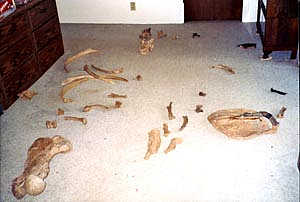 I’ve been studying an old photo Bob Athen took in 2002 of the bones he and Sonya had collected, spread out in their upstairs hallway and arranged as they originally found them. Like a fortuneteller staring at the leaves on the bottom of a teacup, I’m trying to figure out what, if anything, it means about the conditions at the time of death and where we should dig next.
I’ve been studying an old photo Bob Athen took in 2002 of the bones he and Sonya had collected, spread out in their upstairs hallway and arranged as they originally found them. Like a fortuneteller staring at the leaves on the bottom of a teacup, I’m trying to figure out what, if anything, it means about the conditions at the time of death and where we should dig next.
welcome
Excavation in the West Tarkio Valley of southwest Iowa has revealed the second most complete skeleton of an adult Megalonyx jeffersonii ever recovered, lying in situ, and partially intermingled, with the remains of two juveniles. The specimens are buried in primary deposits, offering unprecedented opportunities for research into paleoenvironments during the Pleistocene/Holocene transition and insights into the behavior, habitat, resource partitioning and family associations of this keystone species. See the Project Summary for more information.
